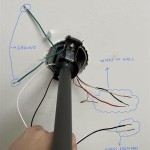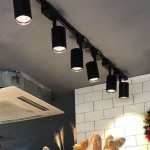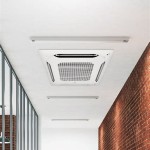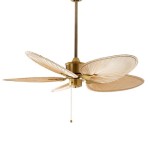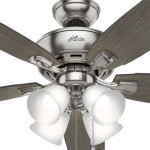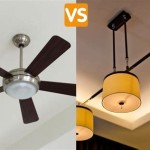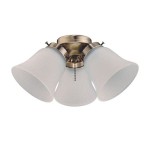Honeywell Ceiling Fan With Remote: Comfort and Convenience at Your Fingertips
The Honeywell ceiling fan with remote represents a significant leap in home comfort technology, offering users unprecedented control over their environment. These fans are designed to provide optimal airflow, energy efficiency, and aesthetic appeal, all managed with the convenience of a remote control. This article delves into the features, benefits, factors influencing choices, and maintenance aspects of Honeywell ceiling fans equipped with remote controls.
Honeywell, a renowned brand in home appliances and electronics, has leveraged its expertise to create ceiling fans that meet diverse consumer needs. Their remote-controlled ceiling fans are not simply about circulating air; they are about enhancing the overall living experience through innovation and ease of use. The integration of remote control technology allows users to adjust fan speed, dim or brighten lights, and even set timers without having to physically reach for a pull chain or wall switch. This is particularly beneficial for rooms with high ceilings or for individuals with mobility limitations.
Key Features of Honeywell Ceiling Fans with Remote
Honeywell ceiling fans with remote share several common features that distinguish them from traditional fan models. These features contribute to their functionality, efficiency, and user-friendliness.
Remote Control Functionality: The core feature of these fans is, undoubtedly, the remote control. These remotes typically offer a range of functions, including fan speed adjustment (often with multiple speeds), light control (dimming and on/off), and sometimes even reverse functionality for seasonal comfort. Some higher-end models may even have learning capabilities to prevent interference with other devices in the home. The remotes are ergonomically designed for easy handling and often come with a wall mount for convenient storage.
Energy Efficiency: Many Honeywell ceiling fans are designed with energy-efficient motors, often utilizing DC (Direct Current) motor technology. DC motors are significantly more efficient than traditional AC (Alternating Current) motors, consuming less electricity while providing the same or even greater airflow. This translates to lower energy bills and a reduced carbon footprint. Some models also boast features like timer functions, which automatically turn the fan off after a set period, further optimizing energy consumption.
Reversible Motor: Most Honeywell ceiling fans with remote include a reversible motor. This allows users to change the direction of the blade rotation, which is crucial for both summer and winter comfort. In summer, the fan should rotate counterclockwise to create a downdraft, providing a cooling breeze. In winter, the rotation should be reversed to clockwise, which gently pushes warm air downwards that has risen to the ceiling, helping to distribute heat more evenly throughout the room and reducing the need for excessive heating.
Integrated Lighting: Many Honeywell ceiling fans come with integrated lighting fixtures. These lights often use LED bulbs, which are known for their energy efficiency, long lifespan, and dimmable capabilities. The remote control allows users to easily adjust the brightness of the lights, creating the desired ambiance for any occasion. The light fixtures themselves are designed to complement the overall aesthetic of the fan and the room.
Variety of Styles and Finishes: Honeywell offers a wide range of ceiling fan styles and finishes to suit any décor. From traditional to modern, and from rustic to industrial, there is a Honeywell ceiling fan to match virtually any aesthetic. The fans are available in various blade finishes, including wood, metal, and plastic, and in different housing finishes, such as brushed nickel, bronze, and white. This variety allows users to choose a fan that not only provides functional benefits but also enhances the visual appeal of their home.
Quiet Operation: Honeywell pays close attention to the noise levels produced by their ceiling fans. Many models are designed with features that minimize noise, such as balanced blades and vibration-dampening technology. This ensures that the fan operates quietly, allowing users to enjoy a peaceful and comfortable environment without the distraction of a noisy fan.
Advantages of Using a Remote-Controlled Ceiling Fan
The integration of remote control technology into ceiling fans offers several distinct advantages over traditional models. These advantages enhance convenience, comfort, and energy efficiency.
Enhanced Convenience: The primary advantage of a remote-controlled ceiling fan is the convenience it offers. Users can adjust fan speed, turn the lights on or off, and even reverse the fan direction without having to get up and physically interact with the fan. This is particularly useful for individuals who are seated, lying down, or have mobility limitations. It also eliminates the need for pull chains, which can be unsightly and difficult to reach, especially in rooms with high ceilings.
Improved Comfort Control: Remote control allows for precise adjustments to fan speed and lighting levels, enabling users to create the perfect ambiance for any situation. Whether it's a gentle breeze for relaxation or a brighter light for reading, the remote control puts the power to customize the environment at the user's fingertips. The ability to easily reverse the fan direction also contributes to year-round comfort, ensuring optimal temperature regulation in both summer and winter.
Increased Energy Efficiency: By providing easy access to fan speed and lighting controls, the remote control can help users optimize energy consumption. Users can easily adjust the fan speed to match their comfort needs, avoiding unnecessary energy waste. The ability to dim the lights also allows for energy savings, as lower light levels consume less electricity. Additionally, the timer function, often included in remote controls, can automatically turn the fan off after a set period, further reducing energy consumption.
Greater Accessibility: Remote-controlled ceiling fans are particularly beneficial for individuals with mobility limitations or for rooms with high ceilings. The remote eliminates the need to reach for pull chains or wall switches, making it easier for everyone to control the fan and lighting. This increased accessibility can significantly improve the quality of life for individuals with disabilities or those who simply prefer the convenience of remote control.
Modern Aesthetics: Many remote-controlled ceiling fans are designed with sleek and modern aesthetics. The absence of pull chains contributes to a cleaner and more streamlined appearance. The remote controls themselves are often designed with a modern look and feel, adding to the overall sophistication of the fan and the room.
Factors to Consider When Choosing a Honeywell Ceiling Fan With Remote
Selecting the right Honeywell ceiling fan with remote involves considering several factors to ensure it meets individual needs and preferences. These factors include room size, ceiling height, style, and budget.
Room Size: The size of the room is a crucial factor in determining the appropriate fan size. A fan that is too small will not provide adequate airflow, while a fan that is too large may be overpowering. As a general guideline, rooms up to 75 square feet require a fan with a blade span of 36 inches or less. Rooms between 75 and 175 square feet require a fan with a blade span of 42 to 48 inches. Rooms between 175 and 350 square feet require a fan with a blade span of 50 to 54 inches. For larger rooms, multiple fans may be necessary.
Ceiling Height: The height of the ceiling is another important factor to consider. For ceilings less than 8 feet high, a hugger or flush-mount fan is recommended. These fans are designed to sit close to the ceiling, maximizing headroom. For ceilings between 8 and 9 feet high, a downrod of 6 to 12 inches is recommended. For ceilings higher than 9 feet, a longer downrod may be necessary to ensure optimal airflow and prevent the fan from being too close to the ceiling.
Style and Finish: The style and finish of the fan should complement the décor of the room. Honeywell offers a wide range of styles, from traditional to modern, and various finishes, such as brushed nickel, bronze, and white. Consider the existing furniture, lighting fixtures, and wall colors when selecting a fan to ensure a cohesive and aesthetically pleasing look. Choose blade finishes that complement the overall style, opting for wood finishes for traditional settings and metal or sleek plastic for modern aesthetics.
Lighting Needs: If the fan will be the primary source of lighting in the room, consider a model with an integrated light fixture. Honeywell offers fans with various lighting options, including LED bulbs, dimmable lights, and different light fixture styles. Determine the desired level of brightness and the type of light that best suits the room's purpose. LED bulbs are generally preferred for their energy efficiency and long lifespan.
Budget: Honeywell ceiling fans with remote are available at various price points. Determine a budget before starting the shopping process to narrow down the options. Keep in mind that higher-priced models often come with more features, such as energy-efficient motors, advanced remote control functionality, and more sophisticated designs. However, there are also many affordable options that offer excellent performance and value.
Motor Type: Consider the motor type, opting for DC motors for superior energy efficiency. While AC motors are more affordable, DC motors consume significantly less energy and offer quieter operation. The upfront cost of a DC motor fan may be higher, but the long-term energy savings can offset the initial investment. In addition, DC motors typically offer a wider range of speed settings.
Remote Control Features: Evaluate the features offered by the remote control. Basic remotes typically include fan speed adjustment and light control. More advanced remotes may offer features such as timer functions, reverse functionality, and learning capabilities. Choose a remote control that meets your specific needs and preferences.
Warranty: Check the warranty offered by Honeywell on the ceiling fan. A longer warranty indicates the manufacturer's confidence in the product's quality and durability. Pay attention to the specific terms of the warranty, including what is covered and for how long.
By carefully considering these factors, users can select a Honeywell ceiling fan with remote that perfectly meets their needs and enhances their overall living experience.
Maintenance of Honeywell Ceiling Fans with Remote
Proper maintenance is essential to ensure the longevity and optimal performance of a Honeywell ceiling fan with remote. Regular cleaning and occasional inspections can prevent problems and extend the fan's lifespan.
Regular Cleaning: Dust accumulation on the fan blades and housing can reduce airflow and cause the motor to work harder, leading to decreased efficiency and potential damage. Clean the fan blades and housing regularly with a soft cloth or duster. For stubborn dirt, a mild soap and water solution can be used, but be sure to dry the surfaces thoroughly to prevent water damage. Avoid using harsh chemicals or abrasive cleaners, as they can damage the fan's finish.
Blade Balancing: Over time, the fan blades may become unbalanced, causing the fan to wobble and make noise. If this occurs, use a blade balancing kit to correct the imbalance. These kits typically include small weights that can be attached to the blades to achieve proper balance. Follow the instructions provided with the balancing kit carefully.
Motor Lubrication: Some Honeywell ceiling fans require occasional motor lubrication. Refer to the manufacturer's instructions to determine if the fan needs lubrication and what type of lubricant to use. Apply the lubricant sparingly, following the directions provided. Over-lubrication can be just as harmful as under-lubrication.
Remote Control Maintenance: Replace the batteries in the remote control as needed. Low batteries can cause the remote to malfunction or stop working altogether. Keep the remote control clean and dry to prevent damage. Avoid dropping the remote or exposing it to extreme temperatures.
Electrical Connections: Periodically check the electrical connections to ensure they are secure. Loose connections can cause flickering lights or even pose a fire hazard. If any loose connections are found, tighten them carefully. If unsure, consult a qualified electrician.
Light Fixture Maintenance: If the fan has an integrated light fixture, replace the bulbs as needed. Use the correct type and wattage of bulbs as specified by the manufacturer. Clean the light fixture regularly to remove dust and debris, ensuring optimal brightness.
Professional Inspection: Consider having the fan inspected by a qualified electrician every few years. A professional inspection can identify potential problems before they become major issues. The electrician can also clean and lubricate the fan as needed.
By following these maintenance tips, users can ensure that their Honeywell ceiling fan with remote provides years of reliable performance and comfort.

Honeywell Eamon 52 Inch Ceiling Fan With Remote And Light Matte Black

Honeywell Kaliza Modern Ceiling Fan With Remote 56 Inch Bright White

Honeywell Byard 52 Outdoor Ceiling Fan With Led Light And Remote Control Matte Black

Honeywell Kaliza Ceiling Fan Color Changing Led And Remote Control 60 Black

Honeywell Kaliza 56 In Pewter With Black Pine Blades Indoor Ceiling Fan Light And Remote 6 Blade 51626 26 At Lowes Com

Honeywell Carmel 48 Inch Ceiling Fan With Integrated Light Kit And Remote Contro Ebay

Honeywell Xerxes 62 In Ceiling Fan With Light Remote Control Matte Black 51473 40

Honeywell Bonterra Led Ceiling Fan With Light 52 Inch Brushed Nickel

Honeywell Glen Alden 52 In Ceiling Fan With 4 Arm Light Oil Rubbed Broe 50183 40 Zoro

Honeywell Ceiling Fans 50201 36 Broe Duval 52 5 Blade Indoor Outdoor Fan Lightingdirect Com
Related Posts
